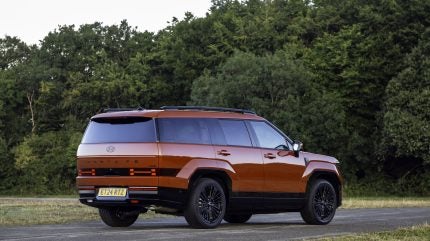
Generation five not only looks radically different to the previous shape model, but at 4,830 mm from bumper to bumper, it’s 45 mm longer too. Various seating layouts exist and thanks to a fairly generous 2,815 mm wheelbase and low floor there is room aplenty even in the third row.
Produced in three countries

Discover B2B Marketing That Performs
Combine business intelligence and editorial excellence to reach engaged professionals across 36 leading media platforms.
The USA and South Korea are key markets for the Santa Fe with production also taking place in both countries. For Europe, vehicles come from one of Hyundai Motor Company’s Ulsan plants whereas Hyundai Motor America builds for its region at the Montgomery factory in Albama. The Beijing Hyundai JV also makes this model and there is some CKD assembly in a handful of other Asian countries.
Hybrid or Plug-in Hybrid for the UK market
Every engine in the Santa Fe has four cylinders and direct injection, capacities being 1.6, 2.0 and 2.5 litres. Neither diesel nor electric drive are available though the smallest unit comes as a hybrid or a plug-in hybrid, these being the UK market choices. It was the first of those two electrified alternatives that Hyundai lent me for this review, the press fleet example being in top-spec Calligraphy trim with 2 x 2 x 2 seating. Dependent on trim level, you can instead have five or seven seats.
Initially I wondered if a 1.6-litre engine could have enough muscle to propel what is a relatively big vehicle but it does. Perhaps the six-speed automatic transmission could do with a couple of extra ratios, that being the only thing which I might suggest in terms of potential drivetrain improvements. In fact, North America’s 2.5-litre turbo does come with an eight-speed auto so we might see that standardised for the HEV and PHEV later in the life cycle.
Looks like no other model in its class
Some have commented on the rear end looking a little strange but I love how quirky it is, the low, horizontal rear lights especially. Perhaps these will become vertical when a mid-life facelift happens, the registration plate also shifting from its low-down position but who knows. What I really like is how HMC has spent money giving us bespoke wheel-arch flares rather than merely blanking out what are not-so-attractive orange/red side lights mandated for the US market model.
All the flush glazing also looks great, the rear window has a wipe-wash system and the blade is hidden, parked under a roof spoiler, mirrors are big, doors open wide and access to the third row is oh so easy. Nor will anyone be hitting their head climbing in or out and in the six-seater layout of the test vehicle at least, there is much space between as well as in front of and behind every occupant.
The tailgate lifts high, the opening is wide and the boot’s capacity, at 628 litres (six- and seven-seaters, or 711 for five-seaters) is excellent. Not to mention there are so very many pull-out, lift-up or pull-down covers which reveal places to store stuff seemingly everywhere. The cubby between the front seats is especially generously sized, while there are two gloveboxes (upper and lower).
Easy to deactivate unwanted ADAS features?
HMC has specified a digital-default dashboard and this works extremely well, though the Santa Fe is quite a beepy car. It is at least easy to switch off Lane Assist, Lane Keeping and/or Speed Limit alerts, this being via one steering wheel button pressed multiple times. The same system features in Genesis models and certain Kias.
Some of that space I mentioned has been liberated by placing P, R, N and D controls on a wand rather than a lever within the central console. You soon get used to it and where these functions might have otherwise been there is a large phone charger pad plus wide-diameter cup holders. Above all this is a digital panel for the HVAC system though there are also real dials for a couple of controls, including music volume.
Wrap-around display
A BMW-style long-low screen positioned immediately ahead of and to the left of the driver works very well too, and has been intelligently designed. Happily it is far from overwhelming, particularly after all the chimes are deactivated. Why so many Korean cars are often continuously naggy-noisy I do not understand: who on earth wants all this distraction?
The Santa Fe isn’t the lightest vehicle in its class though not overly weighty either. It does lean a bit in bends and that might be partly due to how much glass there is. To me the generous glazing is a very good thing for safety’s sake, plus I noticed that windows both front and back full retract into the doors. That’s a boon for getting hot air out of the car quick-smart before the A/C is able to work its magic.
Summary
As a family hold-all, the big Hyundai has a lot in its favour. That includes great economy, acres of space, seating flexibility, good handling and above all, looks that announce it as the very opposite of yet another boring-anonymous SUV.
Power and torque for the Santa Fe Hybrid are 158 kW (215 PS) and 367 Nm (271 lb ft), zero to 62 mph takes 9.5 seconds and top speed is 118 mph. Pricing for the three trim levels starts at GBP 47,890 (Premium), GBP 51,390 (Ultimate) and GBP 53,890 (Calligraphy).






